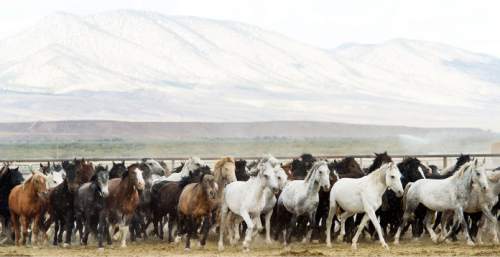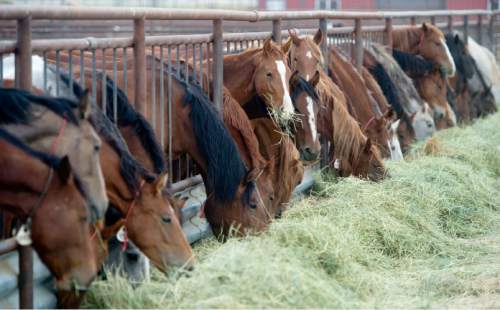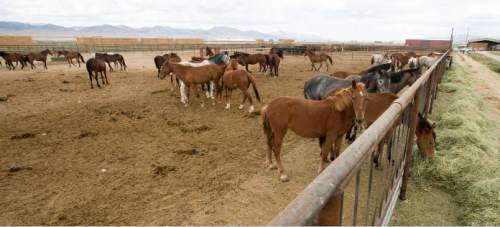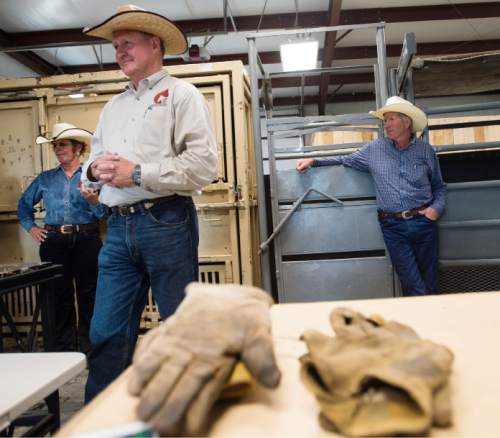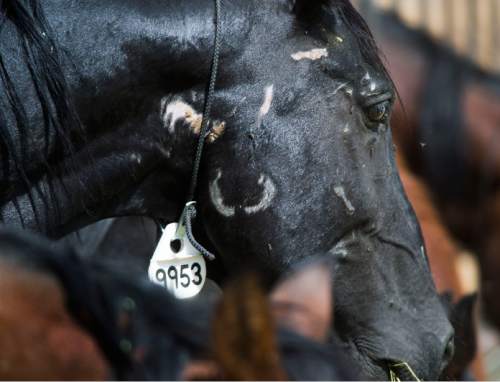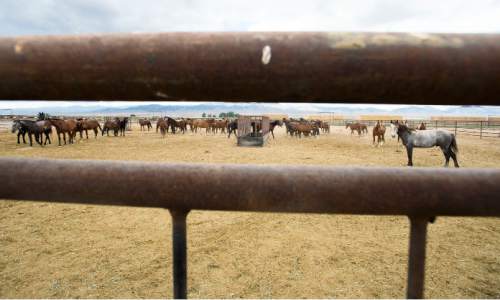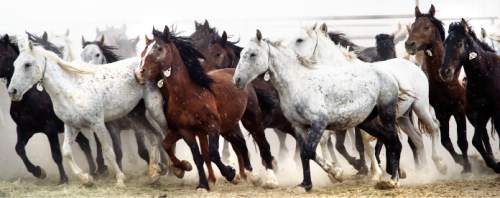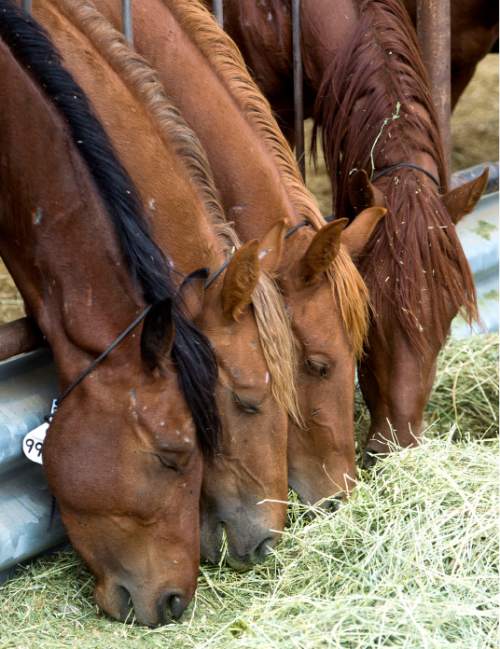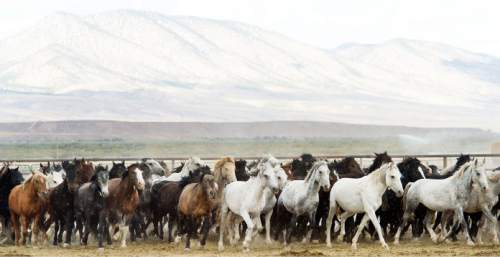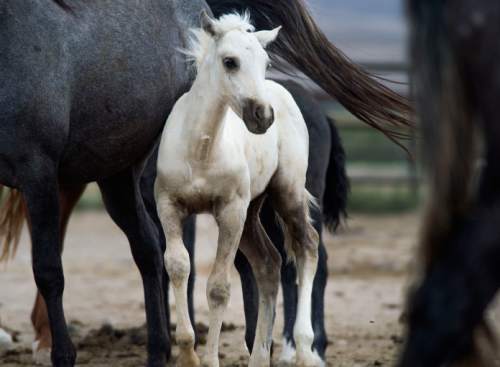This is an archived article that was published on sltrib.com in 2015, and information in the article may be outdated. It is provided only for personal research purposes and may not be reprinted.
Axtell • The wild horses appearing last week at Nannette and Kerry Despain's ranch outside this central Utah town were too emaciated and weak, worn down after a hot summer on the drought-depleted Nevada range, to be fully processed.
Wranglers sorted the 230 horses from the Cold Creek herd by gender and age and put them in pens where they now dine twice a day on alfalfa and grass. Running them through a hydraulic chute to apply freeze brands, take blood samples, clip toe nails and hang numbered tags around their necks can wait.
Kerry Despain pointed out that some foals remained with the mares so they could be weaned.
"If you start messing with these horses, that foal could get trampled," Despain said. "They are docile now. But when you start pushing them, it's fight or flight."
On Monday, the Despains invited news media to their 800-acre ranch two hours south of Salt Lake City to give the public a look inside the off-range wild horse corral they operate on 32 acres. Early this summer they entered into a contract with the Bureau of Land Management to take care of wild horses BLM removes from public rangelands it administers in Nevada, Utah and other Western states.
"We want it to be transparent. We are proud of what we do," said Despain, who ran the now-disbanded mustang program at the nearby Gunnison prison before he retired a few years ago. Since 2011, the BLM has paid Despains to keep hundreds of wild burros on their ranch.
The Despains' new system of 10 pens is holding about 650 horses, but it can handle up to 950. That number hardly puts a dent in the BLM's wild-horse problem. The agency says more than 58,150 horses roam the range — 31,000 more than the number deemed "appropriate." Today, about 46,000 wild equines are held in private corrals and pastures, mostly in the Midwest.
But in Western states, the BLM has struggled with a dearth of short-term holding facilities, particularly in Utah. In recent years, the Central Utah Correctional Facility where Despain worked shut down its corrals where inmates once worked with horses and BLM closed its Herriman corral.
The new Axtell corral is intended to remove some of the pressure on BLM's remaining Delta corral.
About 26 Western ranchers, 12 in Utah, put in bids to provide interim care for horses between the time they are rounded up and when they are shipped east to be adopted or to a permanent home at a long-term pasture.
So far, contracts have been awarded to Despain, as well as ranches in Bruno, Idaho, and another in Fallon, Nev., according to Gus Warr, supervisor for BLM's Utah wild-horse and burro program.
Such contracts are welcomed in the West's rural pockets because they pay a few dollars a day per horse, which can put a million or more dollars into a local economy.
"It gives our ranchers another avenue to stay in business," said Sanpete County Commissioner Steve Frischknect.
But wild-horse advocates are concerned that the expansion of such holding pens heralds an increased reliance on horse removal.
"They continue to put money into warehousing the horses, but they are shortchanging the front end, which is humanely managing the population on the range," said Suzanne Roy, executive director for the American Wild Horse Preservation Campaign. "Their spending on fertility control doesn't even register on their budget, it's less than 1 percent."
For the next year, BLM plans to increase spending on short-term corrals to $30 million and to $26 million for long-term pastures.
Pasture costs in the Midwest are far lower than in the arid West, where the horses' diet has to be supplemented with alfalfa for half the year. It costs BLM $1.85 a day to put up a horse for life on a Kansas ranch, but keeping that same horse at its 300-head corral in Delta costs $5.
Warr said contracting with private ranchers like the Despains reduces costs because it spares the agency the expense of maintaining facilities and hiring employees.
"It's lucrative for ranchers, but the taxpayers are getting stuck with the bill," Roy said. "It would be far cheaper to keep them on the range and reduce [cattle] grazing where needed."
Ranchers and rural Utah county commissioners, however, intensely oppose reduced stocking levels to accommodate what they say is a proliferation of wild horses on public lands.
Caught in the middle of this dispute is the BLM, which is required by federal law to protect free-roaming horses and burros while ensuring the health of the range and accommodating cattle.
The Cold Creek horses barely flinched as human visitors approached the place where they munched on the alfalfa piled along the edge of their pens. These animals are highly acclimated to humans because their home range abuts a residential area west of Las Vegas. As their condition deteriorated this year, people assigned names to horses and left hay on the side of the road for them. Some animals even ventured into yards, looking for something to eat.
"A lot were not going to make to winter, much less through winter," Warr said. "You could see the Joshua trees with the bark chewed off as high as you could reach. That's when you know when things are really tough."
In an emergency round-up this month, the BLM began taking horses off the Wheeler Pass Horse Management Area. Thirty were so weak they had to be euthanized, and the rest were trucked to Axtell.
These skinny horses will spend the next four to six months fattening up before the BLM will prepare them for adoption.
But absent a shift in federal policy, most of the animals passing through Axtell are destined for life as wards of the government.



